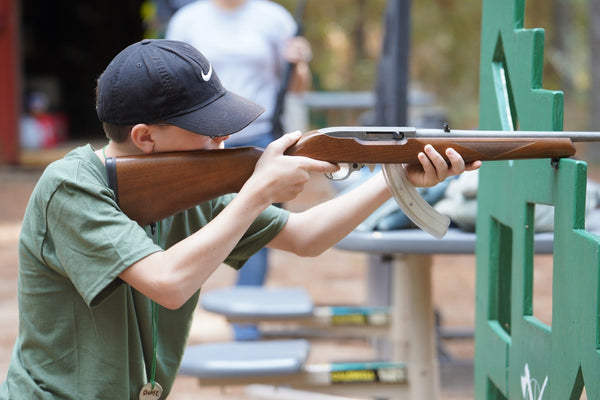The 7 Best Drills for Practicing Your Draw from an Outside-the-Waistband (OWB) Holster
Drawing your handgun efficiently from an Outside-the-Waistband (OWB) holster is a fundamental skill for both defensive and competitive shooters. Whether you're a beginner or an experienced shooter, structured drills help build speed, consistency, and confidence while maintaining safety. Below, we’ll cover the best seven drills to refine your OWB draw, along with essential safety considerations to follow before beginning your training.
Essential Safety Steps Before Training
Before engaging in any dry-fire or live-fire drills, always follow these safety guidelines:
- Use a Safe Training Environment – Ensure you're in a controlled environment, such as a designated range or a dry-fire practice area with no live ammunition present.
- Check Your Firearm – Always perform a chamber check before dry-firing to confirm your gun is unloaded.
- Use a Proper Holster – Your OWB holster should fully cover the trigger guard and provide good retention.
- Wear Proper Gear – A sturdy gun belt, eye protection, and ear protection (for live fire) are essential.
- Start Slow – Focus on smooth execution rather than speed; speed will come with repetition.
- Keep Your Finger Off the Trigger – Do not place your finger on the trigger until your sights are on target and you’ve made the decision to fire.
- Be Aware of Your Muzzle Direction – Always maintain control of your firearm and avoid sweeping yourself or bystanders.
1. The Five-Count Draw Drill
Purpose: Builds a smooth, consistent draw stroke.
Steps:
- Grip the firearm with your strong hand while your support hand remains neutral.
- Draw the firearm straight up until it clears the holster.
- Rotate the muzzle forward toward the target.
- Join your support hand for a two-handed grip.
- Extend and acquire your sight picture.
Repetitions: Start slow and gradually build speed while maintaining control. Perform at least 20 reps per session.
2. The Slow Is Smooth, Smooth Is Fast Drill
Purpose: Reinforces muscle memory and minimizes unnecessary movement.
Steps:
- Perform the five-count draw at 50% speed.
- Gradually increase speed as long as you maintain form.
- Never rush at the cost of sloppiness.
Tip: Record yourself to analyze unnecessary movement.
3. The Shot Timer Drill
Purpose: Develops speed while maintaining accuracy under time pressure.
Steps:
- Set a shot timer for a par time (e.g., 1.5-2 seconds).
- On the beep, draw and fire one round at a designated target.
- Work to consistently beat your par time while staying accurate.
Repetitions: 10-15 reps per session.
4. The One-Shot Draw Drill
Purpose: Focuses on the first shot’s speed and accuracy.
Steps:
- Start from the holster with hands at your sides.
- On the command, draw and fire one shot on target.
- Reset and repeat, ensuring proper grip and sight alignment.
Variations: Start from different ready positions (hands up, hands crossed, etc.).
5. The Failure-to-Stop Drill
Purpose: Trains for defensive shooting by reinforcing follow-up shots.
Steps:
- Draw and fire two shots to the center mass, followed by one shot to the head.
- Focus on recoil control and sight realignment.
- Keep a consistent pace without rushing.
Repetitions: Perform 10 rounds per session.
6. The Movement Draw Drill
Purpose: Reinforces drawing while moving for defensive situations.
Steps:
- Start at the holster and draw while stepping laterally or diagonally.
- Engage the target while maintaining stability and accuracy.
- Ensure proper footwork to avoid tripping or unintentional muzzle movement.
Tip: Start slow and progress to faster movement.
7. The Blind Draw Drill
Purpose: Develops instinctive muscle memory.
Steps:
- Close your eyes, assume a neutral stance, and draw your firearm.
- Open your eyes to check your alignment.
- Repeat to build a natural draw path.
Tip: This should be done dry-fire only.
Final Thoughts
Training with an OWB holster requires consistency, safety, and repetition. Incorporate these seven drills into your routine and focus on form over speed at the beginning. Over time, your draw will become more efficient and instinctive, giving you confidence whether on the range or in a defensive scenario. Stay safe, train smart, and always be aware of your surroundings.
Also in BLOG

7 Reasons the Ruger 10/22 is the Ultimate Starter Rifle (with Pro Tips!)
The most common question received by firearm trainers is "What's the best rifle to start with?" The answer? The Ruger 10/22. This iconic .22 LR semi-automatic rifle is a staple in the shooting community, and for good reason. Whether you're introducing a friend to the sport or looking for a reliable plinker, the 10/22 delivers. Here are seven reasons why it's the perfect choice, each paired with a pro tip to enhance your shooting experience.

Stay Safe on the Road: 7 Warning Signs to Watch for While Traveling with Your Family
Summer road trips should be about adventure, not danger. But traveling through unfamiliar areas can make you a target if you're not aware of your surroundings. Criminals prey on unsuspecting tourists, and the best way to avoid becoming a victim is staying alert and recognizing early warning signs. Here are 7 key red flags to watch for—along with pro tips to keep your family safe on the road.

Lost in the Wild: Avoid These 5 Fatal Mistakes
When you find yourself unexpectedly lost in a survivable wilderness setting, your chances of survival depend as much on your mindset as on your gear. Modern survival experts have seen it all from hikers who panic at the first sign of trouble to those who make impulsive decisions that cost them dearly. Here are the top 5 fatal mistakes people make when lost, and advice to help you avoid them.
